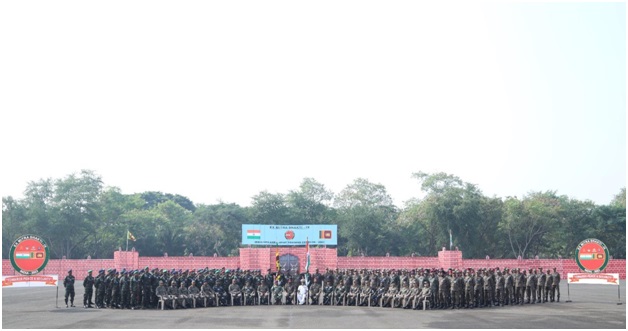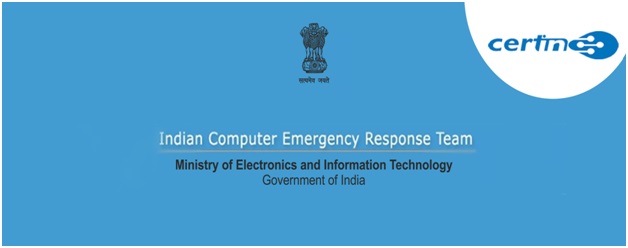Exercise MITRA SHAKTI (PIB)

- 17 Nov 2023
Why in the News?
A joint military exercise, “Exercise MITRA SHAKTI-2023” is being conducted from November 16th to 29th, 2023, in Aundh (Pune).
About Exercise MITRA SHAKTI:
- Exercise MITRA SHAKTI is the ninth edition of a joint military exercise between the Indian and Sri Lankan armies.
- The Indian contingent, consisting of 120 personnel mainly from the MARATHA LIGHT INFANTRY Regiment, is participating alongside personnel from the Indian Air Force and the Sri Lankan Air Force.
- This exercise is the first bilateral and bi-service endeavor between the two countries.
- The primary goal is to jointly practice sub-conventional operations under Chapter VII of the United Nations Charter, emphasizing coordinated responses in counter-terrorism operations.
- The exercise includes training in Army Martial Arts Routine (AMAR), combat reflex shooting, Yoga, and the use of Drones and Counter Unmanned Aerial Systems, along with helicopters.
- Joint drills will cover securing helipads and conducting casualty evacuation during counter-terrorist operations.
- The collective focus is on enhancing interoperability among troops, minimizing risks to life and property, and prioritizing the interests and agenda of the UN in peacekeeping operations.
- Additionally, the exercise aims to strengthen bilateral relations between the neighboring nations.
Sickle Cell Disease (TOI)
- 17 Nov 2023
Why in the News?
The UK's medicines regulator has granted approval for the world's first gene therapy treatment for sickle cell disease.
What is Sickle Cell Disease?
- Sickle cell disease (SCD) is a blood disorder that is passed through the genes and results in abnormal hemoglobin.
- (Hemoglobin is a part of the red blood cells that carry oxygen through the body.)
- People with SCD have red blood cells that sickle or change shape when exposed to low oxygen levels in the cell.
- These sickled cells also become stiff and sticky compared to normal red blood cells.
- They can block blood flow, leading to tissue damage and pain.
- Over time, these blockages can lead to organ dysfunction and result in other serious medical complications.
Sickle Cell Disease Types
- There are several different forms of sickle cell disease, and it is different for each person.
- Hemoglobin SS, also known as sickle cell anemia
- Hemoglobin SC disease
- Hemoglobin sickle beta-thalassemia
- The most common and usually the most severe form is sickle cell anemia.
- The SCD type affects the severity and frequency of complications.
- The type of SCD also impacts the timing of complications.
- Some people have symptoms at a very young age while others will not show symptoms until adulthood.
Sickle Cell Disease Symptoms
- Anemia: Sickled blood cells are less able to carry oxygen, leading to anemia.
- Symptoms can include fatigue, weakness, dizziness, headache, shortness of breath and chest pain.
- Bone Pain: Decreased blood flow to the bones leads to periodic spikes in bone pain known as bone crises.
- SCD can also cause avascular necrosis, which is a breakdown of the bone and joint.
- Eye Disease or Blindness: Sickled blood cells can damage the fragile blood vessels in the back of the eye, leading to retina damage called retinopathy. This can lead to blindness.
- Infections: The spleen fails in SCD patients at a young age, decreasing the body’s ability to fight infections.
- Kidney Issues: Blood in the urine (papillary necrosis), frequent urination, kidney disease.
Treatments:
- A bone marrow transplant (stem cell transplant) can cure sickle cell disease.
- However, there are treatments that can help relieve symptoms, lessen complications, and prolong life.
- Gene therapy is also being explored as another potential cure. The UK recently became the first country to approve gene therapy treatment for sickle cell disease
Indian Computer Emergency Response Team (CERT-In) (Business Standard)

- 17 Nov 2023
Why in the News?
Among 1.39 million cyber security cases last year, vulnerable services made up 875,892 of the total incidents tackled by Cert-In
What is CERT-In?
- CERT-In stands for the Indian Computer Emergency Response Team.
- It is a government agency that functions under the Ministry of Electronics and Information Technology (MeitY).
- It was established in January 2004 with the objective of securing Indian cyberspace.
- It is the national nodal agency for dealing with cyber security threats like hacking and phishing.
- It strengthens the security-related defence of the Indian Internet domain.
- The Information Technology Act of 2000 designated CERT-In to serve as the national agency to perform the following functions in the area of cyber security:
- Prevention of cyber attacks: CERT-In works to prevent cyber attacks by issuing advisories and guidelines to organizations and users.
- It also conducts vulnerability assessments and penetration testing to identify and remediate security weaknesses.
- Incident response: It provides technical assistance to organizations that have been affected by cyber-attacks.
- It helps them to contain and recover from the incident, and to minimize the damage.
- Cyber security awareness: It raises cyber security awareness among the Indian public through various initiatives, such as workshops, seminars, and online resources.
- Coordination with other agencies: CERT-In coordinates with other cyber security agencies in India and around the world to share information and best practices.
- The constituency of CERT-In is the Indian cyber community and Indian cyberspace.
- CERT-In provides services to organisations in the Government, Public, and Private sectors.
- In addition, CERT-In provides services to individuals and home users as well.
- Disclosure of information will be followed in accordance with Indian Constitutional laws.
Worldwide Governance Indicators (Indian Express)

- 17 Nov 2023
Why in the News?
The Indian Chief Economic Adviser recently expressed worry about credit rating agencies using the World Bank's Worldwide Governance Indicators to assess ratings, particularly for developing countries.
About Worldwide Governance Indicators:
- The Worldwide Governance Indicators is based on a long-standing research programme of The World Bank.
- It was first established in 1996 to measure the quality of governance in over 200 countries.
- These aggregate indicators are derived from over 30 individual data sources produced by a variety of survey institutes, think tanks, non-governmental organizations, international organizations, and private sector firms.
- The indicators capture six key dimensions of governance including:
- Voice and Accountability
- Political Stability and Absence of Violence
- Government Effectiveness
- Regulatory Quality
- Rule of Law
- Control of Corruption
- According to The World Bank, corruption is the single greatest obstacle to economic and social development.
About The World Bank:
- The World Bank is an international financial institution that provides financial and technical assistance to developing countries around the world.
- Its goals are to reduce poverty and support development.
- It helps by offering a growing range of free tools, research, and knowledge to help people address the world’s development challenges, for instance, comprehensive, downloadable indicators about development in countries around the globe.
Wasp-107b (TOI)

- 17 Nov 2023
Why in the News?
In its latest discovery, NASA's James Webb Space Telescope has discovered a planet "Wasp-107b" where specks of sand fall as rain.
What is “Wasp-107b”?
- WASP-107b is a warm exoplanet with Neptune’s mass and Jupiter’s radius.
- This makes it ‘fluffy’ compared to the giant gas planets in our Solar System.
- This unusual size-to-mass ratio has given astronomers a unique opportunity to probe its atmosphere roughly 50 times deeper than more dense planets like Jupiter.
- This gas giant, often referred to as a "super-Neptune," holds several remarkable characteristics that set it apart from other known exoplanets.
Key Characteristics of WASP-107b:
- Size and Mass: WASP-107b is roughly the size of Jupiter, but with only about 12% of Jupiter's mass.
- This makes it one of the least dense exoplanets ever discovered.
- Orbit and Proximity: WASP-107b orbits its host star, WASP-107, very closely, completing an orbit in just 5.7 days.
- It is located about 200 light-years from Earth in the constellation Virgo.
- Sand Rain: WASP-107b exhibits a unique water cycle similar to Earth's, but with a peculiar twist: instead of water droplets, the planet experiences sand rain.
- These sand grains, composed of silicates, rise from lower atmospheric levels and condense into clouds before falling back down.
- Atmosphere: WASP-107b possesses a puffy atmosphere, likely due to its low density.
- In 2018, scientists using the Hubble Space Telescope detected helium in its atmosphere, marking the first detection of this element in an exoplanet's atmosphere.
- Potential for Atmospheric Characterization: WASP-107b's large size and proximity to its star make it a promising target for future atmospheric characterization studies.
- Scientists hope to glean more insights into the composition and dynamics of its atmosphere.
